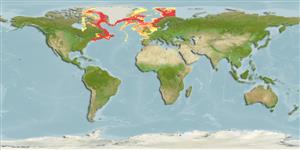Cephalopoda |
Octopoda |
Octopodidae | Bathypolypodinae
Environment: milieu / climate zone / ระดับความลึก / distribution range
นิเวศวิทยา
; ระดับความลึก 14 - 2700 m (อ้างอิง 275), usually 200 - 600 m (อ้างอิง 3737). Temperate; 4°C - ? (อ้างอิง 1971); 84°N - 41°N, 127°W - 30°E
Atlantic Ocean and the Arctic. Temperate to polar.
Length at first maturity / ขนาด / Weight / Age
วัยเจริญพันธุ์: Lm ? range ? - ? cm Max length : 10.0 cm ML เพศผู้/กระเทย; (อ้างอิง 275); common length : 6.0 cm ML เพศผู้/กระเทย; (อ้างอิง 275); น้ำหนักสูงสุดที่มีการรายงาน: 400.00 g (อ้างอิง 275)
Maximum total length is 20 cm (Ref. 122093). Maximum depth from Ref. 1985.
Life cycle and mating behavior
วัยเจริญพันธุ์ | การสืบพันธุ์ | การวางไข่ | Eggs | ความดกของไข่ | Larvae
Members of the class Cephalopoda are gonochoric. Male and female adults usually die shortly after spawning and brooding, respectively. Mating behavior: Males perform various displays to attract potential females for copulation. During copulation, male grasp the female and inserts the hectocotylus into the female's mantle cavity where fertilization usually occurs. Life cycle: Embryos hatch into planktonic stage and live for some time before they grow larger and take up a benthic existence as adults.
Roper, C.F.E., M.J. Sweeney and C.E. Nauen 1984 FAO Species Catalogue. Vol. 3. Cephalopods of the world. An annotated and illustrated catalogue of species of interest to fisheries. FAO Fish. Synop. 125(3):277p. Rome: FAO. (อ้างอิง 275)
IUCN Red List Status
(อ้างอิง 130435: Version 2025-1)
CITES status (อ้างอิง 108899)
Not Evaluated
CMS (อ้างอิง 116361)
Not Evaluated
Threat to humans
Human uses
การประมง: ผลประโยชน์ที่น่าจะเกิดขึ้น
| FishSource |
เครื่องมือ
ข้อมูลเพิ่มเติม
Life cycleการสืบพันธุ์วัยเจริญพันธุ์ความดกของไข่การวางไข่EggsEgg developmentLarvae Human RelatedStamps, coins, misc.
แหล่งที่มาจากอินเตอร์เน็ต
Estimates based on models
Preferred temperature
(Ref.
115969): 1 - 9.6, mean 4.1 (based on 815 cells).
Fishing Vulnerability
Low vulnerability (10 of 100).
